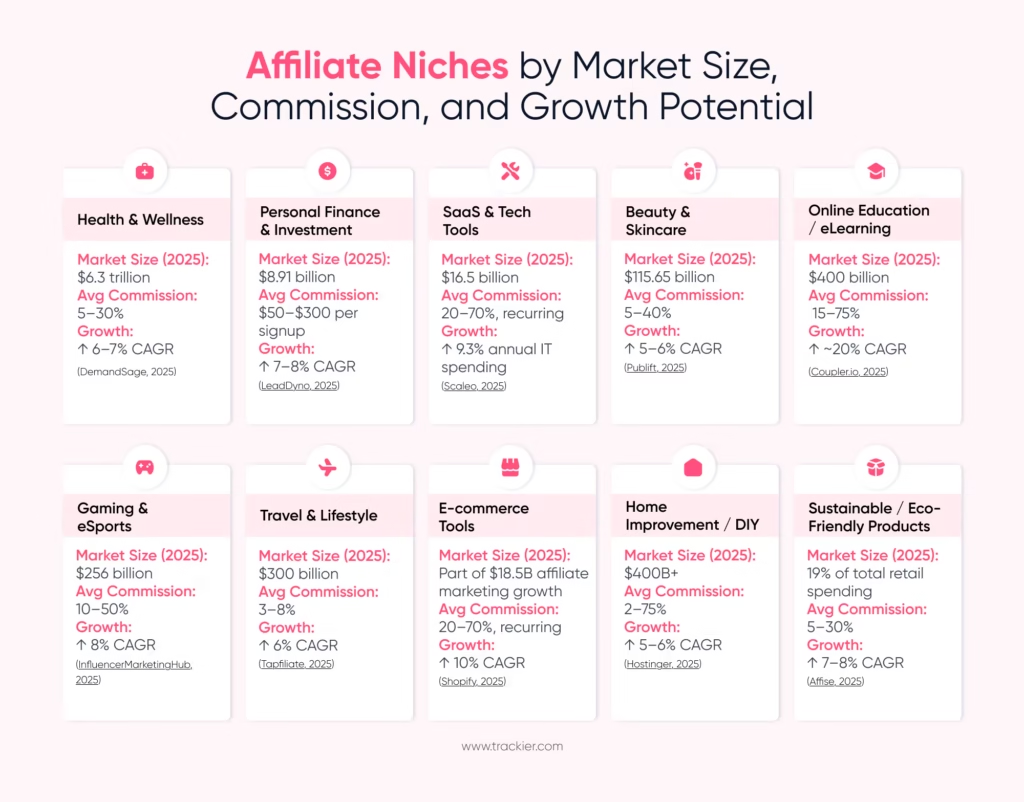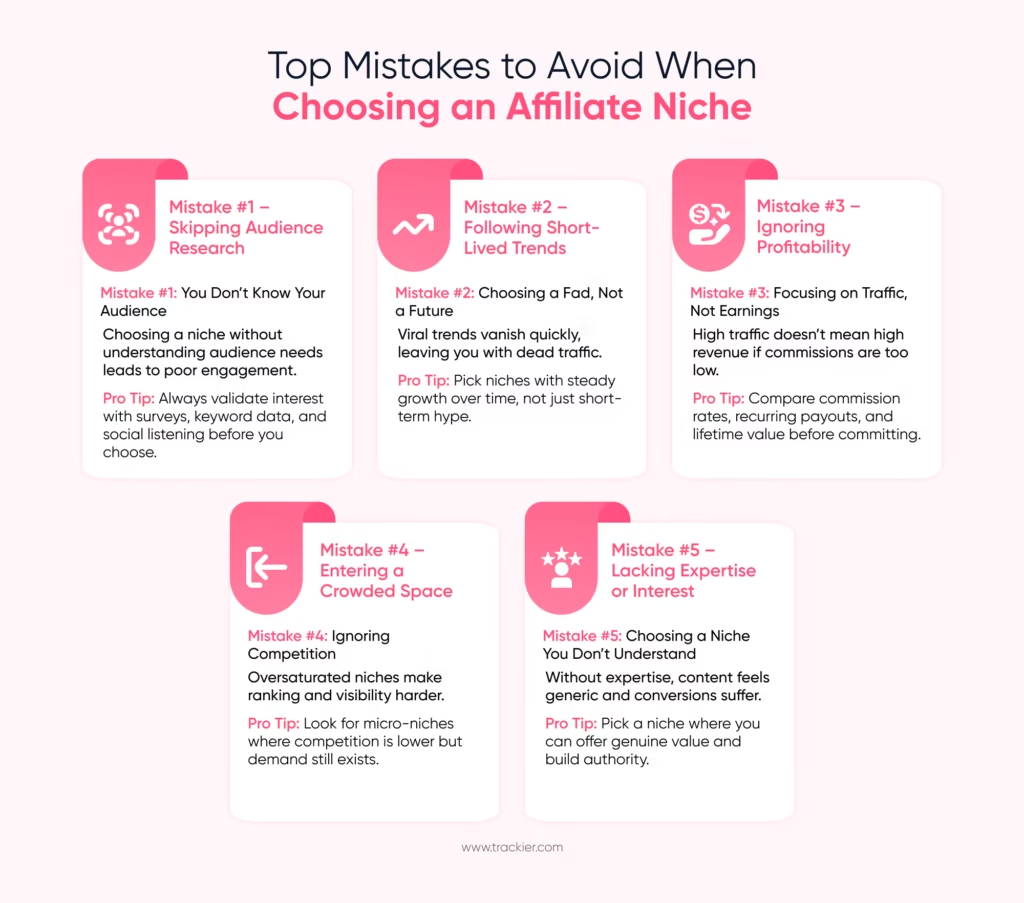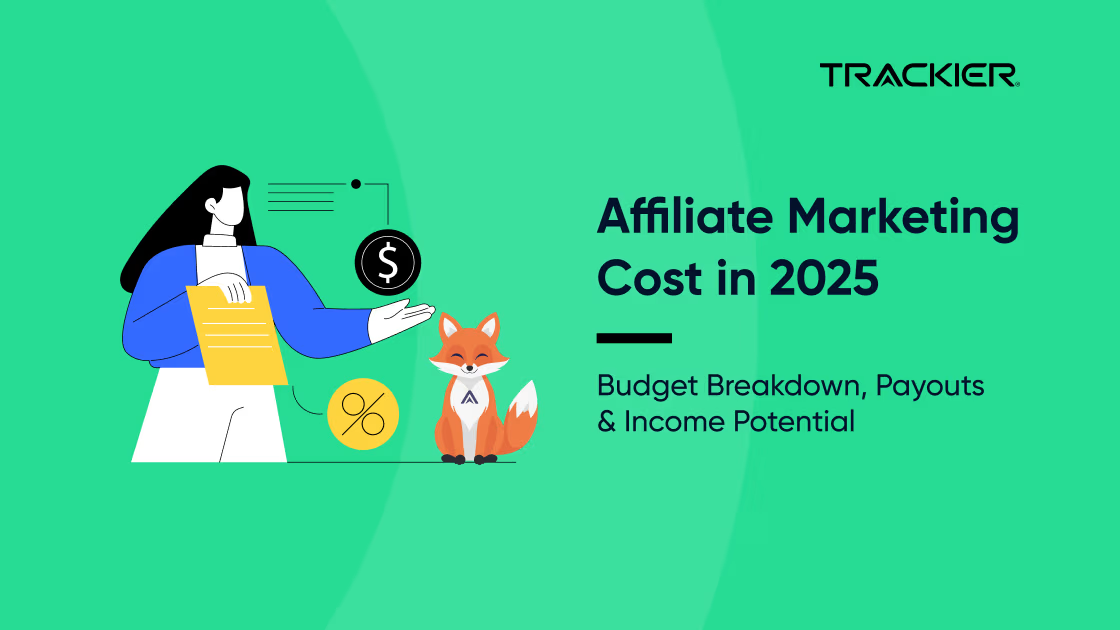Picking the right affiliate niche can determine how successful you become in affiliate marketing.
With the countless options available today, knowing where to focus your efforts is very important. The most profitable affiliate niches are the ones that balance audience interest, market demand, and potential earnings perfectly.
Understanding which niches generate consistent revenue can save months of trial and error for teams. In this blog, we will explore the top affiliate marketing niches for 2025, how to choose one that matches your audience, and which niches offer the highest payouts.
For a head start, check out our Trackier Affiliate Marketing Solutions to see how top programs track, optimize, and scale effectively.
What Are Affiliate Niches and Why Do They Matter?
Affiliate niches are basically a specific topic, market, or category that you focus on when promoting products or services through affiliate marketing.
Choosing the right niche helps you target the right audience, create relevant content, and increase the chances of earning commissions. Without a clear niche, your efforts can end up scattered, making it harder to stand out in a competitive market.
The right niche also determines which affiliate programs you can join. For example, if you focus on health and wellness, you can promote supplements, fitness apps, or wellness subscriptions. If your niche is technology, software tools or SaaS products may be a better fit.
Picking a profitable niche ensures your time and marketing resources lead to real revenue.
When selecting affiliate niches, consider three factors: market demand, audience interest, and potential profitability.
How to Pick the Right Affiliate Niches for Your Business?
Finding the right affiliate niches is not random. It requires research, strategy, and understanding both your audience and the market. Choosing wisely can save time, increase conversions, and maximize your earnings. Here’s how to do it step by step.
Understand Your Audience and Their Needs
Start by knowing who you’re talking to. What problems do they face? What solutions are they actively searching for? For example, if your audience is startup founders, they might be interested in SaaS tools or marketing software. If your audience is fitness enthusiasts, health supplements or workout apps might fit better. Focusing on audience needs ensures your content resonates and drives real engagement.
Check out our partner marketing strategies for tips on aligning products with audience interests.
Research Market Demand and Competition
Next, see if your niche has enough demand. Use keyword research, trend tools, and competitor analysis to understand what’s popular and where gaps exist. A high-demand niche increases your chances of clicks and conversions. At the same time, study competitors to identify unique angles you can use.
Analyze Profitability and Affiliate Programs
A niche may be popular, but is it profitable? Look at commission rates, average order value, and recurring revenue potential. High-paying affiliate programs in tech, finance, or SaaS often outperform low-ticket products in terms of long-term earnings. Selecting niches with profitable programs ensures your marketing efforts lead to tangible revenue.
Learn more about affiliate programs and monetize your budgets better.
What Are the 10 Most Profitable Affiliate Niches in 2025?
The affiliate marketing industry is experiencing unprecedented growth, with over 80% of brands now utilizing affiliate marketing programs and businesses earning an average of $12 for every $1 spent on affiliate marketing, selecting the right niche is crucial for maximizing your revenue potential.
Here’s a breakdown of the top 10 most profitable affiliate niches, as per current data and trends:
1. Health and Wellness
The global wellness market hit $6.3 trillion in 2023 and is racing toward $9 trillion by 2028.
Commission Rates range from 5% to 30%, with some high-end brands offering even more. Premium CBD products can offer up to 30% commission rates.
Health and wellness products typically have high customer lifetime value due to repeat purchases of consumables like supplements, vitamins, and skincare products. Post-pandemic awareness has accelerated growth, with more people prioritizing mental health, immunity, and fitness than ever before. The niche offers incredible variety, from physical products to digital services and subscription-based offerings.
Sub-niches: Sleep optimization, stress management apps, superfoods and supplements, sustainable wellness products, alternative medicine, fitness equipment, and mental health tools.
2. Personal Finance and Investment
The personal finance software market is set to grow from $8.91 billion in 2025 to $14.81 billion by 2034. Financial affiliate programs consistently rank among the highest-paying in the industry.
Commission rates range between $50-$300 per approved credit card signup, $50-$150 per loan application, $30-$100 per new investment or savings account. Some programs offer up to 50% commission rates, with trading platforms paying up to $455 per qualified trader.
Financial literacy is on the rise, creating massive demand for financial education and investment platforms. These are evergreen products with high average order values and strong conversion rates among target audiences. The increasing demand for budgeting apps, investment platforms, and financial tools creates multiple revenue streams.
Sub-niches: Budgeting apps, investment platforms, credit monitoring services, cryptocurrency trading, loan services, tax preparation software, and financial education courses.
3. Technology and Software (SaaS)
Global IT spending is growing by 9.3% annually. The SaaS affiliate market collectively drives over $16.5 million in revenue with programs averaging 7,854 referred leads and 3,657 conversions per program.
20% to 70% commission rates, among the highest in the affiliate industry. Many offer recurring commissions as long as customers maintain subscriptions.
Software companies can afford generous commissions due to high customer lifetime values. The tech industry’s continuous expansion and growing reliance on software solutions across various sectors creates constant demand. SaaS products often feature recurring revenue models, providing affiliates with ongoing passive income.
Sub-niches include web hosting services, productivity tools, AI-powered software, podcasting equipment, marketing automation, CRM systems, and cybersecurity solutions.
4. Beauty and Skincare
The global beauty industry is set to reach $128.89 billion by 2028. The global skincare market hit $115.65 billion in 2024, with projections soaring to $194.05 billion by 2032.
Commissions range from 5% to 30% commissions, with beauty subscription boxes and premium brands offering higher rates. Some specialty programs offer up to 40% commission.
Beauty is one of the most profitable niches in affiliate marketing, with 28% of affiliate marketers promoting beauty brands. The industry offers high repeat purchase rates, visual content opportunities perfect for social platforms, and strong brand loyalty. Beauty shoppers are particularly likely to purchase based on influencer recommendations.
Sub-niches: K-beauty, organic skincare, makeup for different skin types, sustainable beauty products, hair care, men’s grooming, and clean beauty.
5. Online Education and E-Learning
The global eLearning market is forecasted to reach $400 billion by 2025, with potential to expand to $1 trillion by 2028. The MOOC market was valued at $12.5 billion in 2024 and could soar to $112 billion by 2031.
Commission rates can go up to 45% for major platforms like Coursera, 15% for workforce training programs, and up to 75% for digital info products on platforms like ClickBank. Affiliate commissions in online education can reach 30% with an ROI of up to 900%.
The shift to online learning has created massive demand for educational content. High average order values for professional certification programs ($3,900 average) compared to basic courses ($80-90) provide significant earning potential. Among eLearning professionals earning over $100K annually, 70% report online courses as their primary income source.
Sub-niches: Professional certification, skill-based courses, language learning, business training, IT courses, creative arts education, and academic degrees.
6. Gaming and eSports
The gaming industry is thriving with a significant increase in players and viewers globally. Gaming affiliate programs offer some of the highest commission rates in the entertainment sector.
Commission rates reach up to 50% for gaming guides and digital products, 10% for gaming peripherals, and up to 20% for gaming services. Premium gaming equipment commands high average order values, making each conversion potentially lucrative.
Gaming offers diverse revenue streams from hardware and peripherals to digital guides and services. The industry benefits from passionate audiences with high spending power and repeat purchase behavior. Gaming content performs exceptionally well on platforms like YouTube and Twitch.
Sub-niches: Gaming peripherals, digital guides, gaming chairs, streaming equipment, game keys, dating services for gamers, and professional gaming services.
7. Travel and Lifestyle
The global travel industry is expected to hit $300 billion in 2025. Travel and tourism revenue reached $925 billion at the end of 2024, with 78% of travelers booking based on ads and social posts.
Commission rates can vary based on bookings, with hotel and flight commissions typically ranging from 3-8%. Travel affiliate programs often feature high average order values due to expensive bookings.
Despite global challenges, the travel industry is recovering strongly with consumers eager to explore new destinations. Travel purchases like plane tickets and resort stays are big-ticket items with substantial commission potential. The industry represents around 16% of global affiliate revenue.
Sub-niches: Luxury travel, budget backpacking, van life, solo female travel, travel insurance, accommodation booking, and travel gear.
8. E-commerce Tools
The rise of online businesses has dramatically increased demand for e-commerce tools and SaaS solutions. This sector benefits from the broader $18.5 billion affiliate marketing industry growth.
Commission rates can be anywhere from 20% to 70% for SaaS tools, with many offering recurring commissions. E-commerce platforms and payment gateways typically offer competitive rates due to high customer lifetime values.
Every online business needs tools for operation, creating consistent demand. The recurring nature of SaaS subscriptions provides ongoing commission income. High customer lifetime values allow for generous commission structures.
Sub-niches: Shopify and e-commerce platforms, payment gateways, email marketing tools, analytics software, inventory management, and conversion optimization tools.
9. Home Improvement and DIY
The home improvement market is flourishing as more individuals invest in their living spaces, with significant growth in the DIY sector during and after the pandemic.
Commission rates range from 2-8% for major retailers like Home Depot and Lowe’s, up to 75% for digital DIY guides and courses, with some programs offering $20-$200 per qualified lead.
Home improvement projects typically involve high-value purchases with excellent commission potential. The DIY trend has created demand for both physical products and educational content. Seasonal projects and home trends provide consistent content opportunities.
Sub-niches: Power tools, home decor, renovation supplies, DIY guides, smart home gadgets, gardening supplies, and home security systems.
10. Sustainable and Eco-Friendly Products
Eco-friendly products now account for 19% of all retail spending, with shoppers paying up to 27.6% more for brands that align with their values. The sustainability movement is reshaping consumer purchasing decisions across all demographics.
Commission rates are often competitive, ranging from 5% to 30%, with sustainable brands often offering competitive commissions to align with conscious consumers.
62.7% of Gen Z consumers consider sustainability important when making purchasing decisions. The growing emphasis on environmental responsibility creates opportunities across multiple product categories. Affiliates promoting eco-friendly brands often see higher engagement and conversion rates due to passionate, values-driven audiences.
Sub-niches: Sustainable fashion, eco-friendly beauty products, green technology, renewable energy solutions, zero-waste products, organic food, and environmentally conscious home goods.

How to Pick the Best Affiliate Niches for Your Business
Choosing the right affiliate niches is one of the most important decisions you’ll make. It shapes your earning potential, influences the type of audience you attract, and affects how quickly you can scale. The good news is you don’t need to guess. By looking at a few key factors strategically, you can narrow down a niche that’s both profitable and a good fit for your business.
1. Understand Your Audience and Their Needs
Start by identifying who you want to reach and what they care about. A niche is only valuable if it solves real problems or matches real interests. If your audience is made up of small business owners, SaaS tools, payment gateways, or email marketing platforms might resonate more than beauty products. If you focus on Gen Z audiences, wellness, personal finance apps, or eco-friendly brands may perform better.
Look for niches where demand and intent are clear, for instance, people searching for “best budgeting app” or “best skincare for sensitive skin” are already considering a purchase. Building content around these intent-rich topics can significantly boost your affiliate conversions.
2. Validate Market Demand with Data
Before committing, check whether the niche has consistent interest and growth potential. You can use tools like Google Trends or keyword research platforms to see if search volume is stable or rising. Market reports are also a good indicator.
Also, pay attention to seasonality. A travel niche might spike in summer, while fitness and wellness peak in January. Choosing a category with year-round demand ensures more predictable revenue.
3. Check Commission Rates and Earning Models
Some niches pay much higher commissions than others, and that directly impacts your revenue. Financial affiliate programs, for instance, can offer $50–$300 per signup, while SaaS tools often pay 20%–70% recurring commissions. Even if two niches have similar traffic potential, the one with better payout structures can deliver far more income.
Look beyond just the upfront commission, factors like recurring revenue, upsells, and subscription renewals can significantly increase total earnings per customer.
4. Assess Competition and Content Saturation
Highly profitable niches usually attract more affiliates, but too much competition can make it harder to rank and convert. Search for top keywords in your potential niche and see how strong the existing content is. If the space is dominated by major publishers, you may need a more specific angle, for example, instead of “fitness,” focus on “home fitness equipment for beginners.”
Micro-niches often have lower competition and more targeted audiences, which can make them more profitable in the long run despite being smaller.
5. Align With Your Expertise and Brand
Finally, consider your own knowledge and credibility. Promoting products in a niche you understand deeply makes content creation easier and builds trust with your audience. Affiliates who genuinely know their topic can create more helpful reviews, tutorials, and recommendations, and audiences are more likely to convert when they sense authenticity.
Picking the right affiliate niches is about finding the balance between demand, profitability, competition, and personal alignment. When those factors line up, you position yourself to lead in the market.

Where to Go From Here
Picking the right affiliate niches is the base of everything you’ll build on top, this includes your content, your partnerships, your revenue model, everything.
When you choose a niche that has consistent demand, pays well, and aligns with what your audience actually wants, you’re not just promoting products. You’re creating a system that keeps earning month after month.
Now that you know what separates strong affiliate niches from risky ones, here’s what you should do next:
- Validate before you dive in. Use tools like Google Trends, SEMrush, or Ahrefs to see if interest in your niche is rising and what the competition looks like.
- Start small, scale fast. Don’t spread yourself across too many products or categories at the start. Focus on one high-potential sub-niche, build authority, and expand once you’ve gained traction.
- Measure and iterate. Track key metrics like CTR, EPC, and conversion rate. If a niche isn’t delivering, don’t hesitate to refine your approach or pivot.
And remember, the real growth happens when great niche choices meet reliable affiliate tech. A platform like Trackier helps you manage partners, track conversions, and optimize campaigns in one place. It helps you focus on strategy instead of manual time consuming tasks.
Hungry for more? Download our free case studies that cover real stories.
Or sign up for the Trackier’s newsletter to get weekly best practices on referral programs and partner marketing.
FAQs
1. Which are the best affiliate niches for affiliate marketing?
The best affiliate niches depend on your audience, expertise, and income goals, but categories like finance and investing, health and wellness, AI tools, and online education consistently outperform others. These niches combine high demand with strong commission rates, recurring revenue potential, and long-term growth. Choosing a niche with sustainable interest ensures stable conversions and reliable earnings.
2. Which affiliate niches have high demand?
Niches that address recurring needs or major consumer pain points usually see the highest demand. In 2025, personal finance, fitness and wellness, AI-powered productivity tools, and eco-friendly living are among the fastest-growing areas. These sectors attract large, engaged audiences actively searching for solutions, making them ideal for affiliates who want consistent traffic and steady revenue potential throughout the year.
3. What is the highest-paying niche?
Finance and investing remains the highest-paying affiliate niche, often offering commissions from $50 to over $500 per sale for products like credit cards, trading platforms, and insurance plans. Other lucrative categories include B2B SaaS, enterprise software, and web hosting, where high customer lifetime value (LTV) and recurring subscriptions lead to substantial earnings and long-term passive income opportunities for affiliates.
4. What are the three main affiliate niches?
Most affiliate programs fall into three major niches: Wealth, which includes finance, investing, and business growth; Health, which covers fitness, nutrition, and wellness; and Relationships, which spans dating, parenting, and lifestyle. These categories are evergreen, attract massive audiences, and support numerous profitable sub-niches, making them ideal starting points for affiliates looking to build sustainable income streams over time.
5. How do I pick a niche?
Choosing the right affiliate niche starts with understanding audience demand, profit potential, and your personal expertise. Research search trends and market size, analyze commission structures, and study your competition. Then, narrow down to a niche you can speak about authentically and consistently. A topic that aligns with your strengths and solves real user problems has the highest chance of long-term success.



